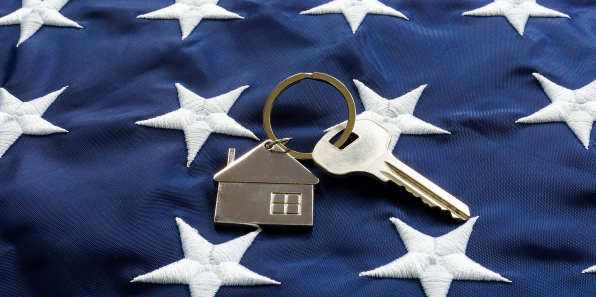The VA home loan program is an amazing benefit for our deserving active-duty service members, veterans, and surviving spouses of veterans. While no one could ever repay you for the sacrifices you’ve made, the VA loan was created to make your dreams of homeownership just a little easier to achieve.
This program is part of the GI Bill, which was signed into law by President Franklin Delano Roosevelt (FDR) in 1944. At that time, a VA loan maxed out at $2,000, with half of that guaranteed by the government.
As you can imagine, a lot has changed since then. Most of these changes have been positive, providing even more benefits to eligible VA borrowers, but they’ve also brought about some confusion and unwarranted assumptions. The last thing we want is for anyone to fall victim to VA home loan myths.
So, take a few minutes to separate fact from fiction. This can help you ensure that these common VA home loan myths won’t derail your American Dream.
VA Funding Fees
MYTH: the VA Funding fee will make my loan payments unaffordable.
While there are many benefits to the VA home loan program, like with all mortgages, there are fees involved. The biggest difference in the VA funding fee is that it is a one-time upfront fee that can be paid in multiple ways. Yes, it can be wrapped into the loan amount and paid monthly with a small bump to your monthly payment. But it can also be paid by the seller or even paid with gift funds from a friend or family member. However you pay it, it doesn’t come close to the monthly fees on conventional loans, such as PMI, which can run hundreds of dollars per month.
Loan Timeline
MYTH: VA loans have a lot of red tape and take longer to close.
VA loans tend to take about the same amount of time to close as a standard conventional loan or FHA loan. The biggest factors involve getting preapproved, getting your Certificate of Eligibility (CoE) as soon as possible (we can help with this), and finding a home that meets the criteria for a VA home loan.
Appraisals in some more rural areas can take a little longer than average because some areas have a shortage of VA appraisers. Additionally, any repairs on the appraisal that are marked as “subject to” must be completed prior to close.
Jumbo Financing
MYTH: Jumbo financing is not available for VA loans.
Another one of those VA home loan myths—busted! VA absolutely offers jumbo loans. In fact, as of 2019 there is no limit on the loan amount at all, except as limited by your benefit entitlement listed on your Certificate of Eligibility. The maximum loan amount (assuming you meet the other qualifications) is only limited by the purchase price of the property and the amount of your entitlement.
APM is proud to offer VA loans up to $1.5 million to make sure you have the runway you need to purchase the home that’s right for you and your family.
Multiple VA Loans
MYTH: You can only use your VA home loan benefit once, or you can’t purchase a second home with a VA loan if you already own a home.
You are absolutely able to use your benefit more than once, and you can even use it for multiple VA loans. As mentioned above, the only limit is the amount of your entitlement. If you have more entitlement left, you can use it for another home. If you use your benefit and then sell your home, the entitlement is fully reinstated.
If you’re a service member, veteran, or eligible surviving spouse, the VA home loan benefit is here for you. Period. Becoming a landlord and earning rental income is part of the American Dream for many individuals, and that includes our military heroes.
Whether you’re looking to downsize or expand, you are welcome to purchase a new home with a VA loan even if your current home was also financed through a VA loan.
Foreclosures and VA Loans
MYTH: I can’t get another VA home loan because I lost my entitlement in a foreclosure.
Here’s a truth bomb for you—service members, veterans, and eligible surviving spouses can use their VA entitlement again, even if they’ve fallen on hard times. You can purchase a home using a VA loan as soon as two years after a foreclosure or bankruptcy has occurred.
We know this process can be tricky, which is why our trusted APM loan advisors are here to help you navigate the VA loan process, regardless of your circumstances.
VA Loan Costs
MYTH: VA loans cost the buyer and seller more money.
VA loans typically have fewer costs for all involved in the transaction. While it’s true that the program allows for sellers to pay the funding fee, it’s not a requirement. The funding fee itself is a fraction of what many other fees the seller contributes towards on a conventional loan, for instance. All fees charged on VA loans are regulated by the federal government and are typically lower across the board than other, more traditional loan types.
VA Loan Eligibility
MYTH: The VA home loan benefit is only for those who have served and are out of the military
VA loans are available to anyone who meets the criteria, including those still in active service. If you are still serving but have met the requirements, you are absolutely able to use your benefit, and if you’re living off base you can even use your BAH towards your home loan payments.
We know there are other VA home loan myths out there, which is why we also want you to know that we are happy to walk you through the process to help you decide if a VA loan works for you. We’re also happy to address any other VA home loan questions you may have—and help you sift through the myths and the facts. Click here to connect with Your Mortgage Sensei your VA Loan Specialist and we’ll set the record straight once and for all.
Disclaimer: Rates, terms, programs and underwriting guidelines subject to change without notice. This is not an offer to extend credit or a commitment to lend. All loans subject to underwriting approval. Equal Housing Opportunity



